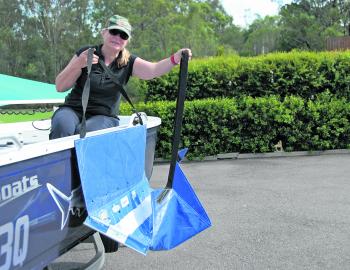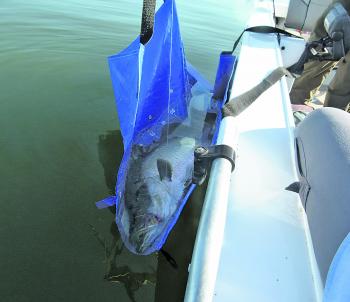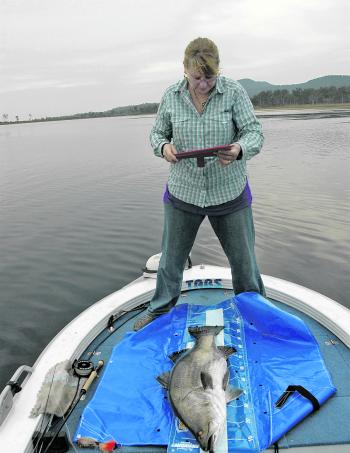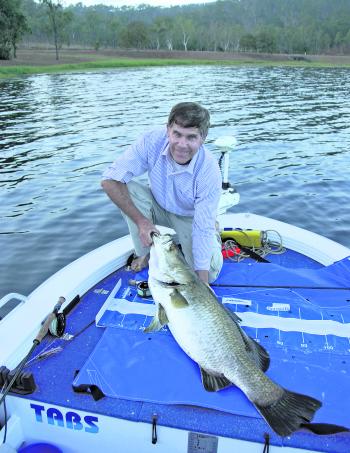The chance of catching a big barra in one of our stocked impoundments has never been better. All of the major barra lakes are exciting anglers this summer, and some mighty big fish are pulling like tractors and taking to the air.
Understandably, anglers with their first really big barra in their boat don’t realise how fragile that great big fish is. These anglers are often surprised to find that upon release, after the photo shoot ends, the fish turns belly up and won’t swim away. Even holding it by the tail and moving it vigorously back and forth in the water won’t revive some fish if they have been treated roughly. It’s a pretty miserable yet not that uncommon sight to see dead barra at the lake’s edge, or a fish going around in endless circles on top of the water.
The reality is that although plenty of anglers might like to release their barra unharmed, it’s something that requires correct handling of the fish from the outset. Let’s face it, a metre-long barra is a big, heavy beast, with giant spikes sticking out aggressively, and scalpel-sharp gill covers into the bargain. There’s also plenty of slime all over it. Without a decent, soft, fish-friendly net, that big fish is difficult to get into the boat. Of course, barra can be unhooked easily at the side of the boat, but if the fish is a milestone or personal best who can blame the angler for wanting it aboard to take photos of this momentous event!
I’ve found that a big barra is easy enough to get boatside when it stops struggling, but these fish are hard to get aboard without the assistance of a barra-sized landing net, especially if the boat is small. Hoisting the fish in with a fish grip to the jaw is going to harm it very badly, especially if it’s dragged over the side. It’s far better to plan ahead, and work out just how to gently ease it in the boat for a couple of quick pics, and release it with some help to kickstart it.
A successful catch and release depends a lot on the state of the fish. If a barra takes a long time to bring to the boat and is clearly exhausted, I don’t use the net. Instead, I use a special sling or lifting cradle I’ve had made to bring the fish gently up and into the boat.
My own cradle/sling was made from a common BCF brag mat, with additional soft material sewn onto each side and with webbing (similar to seat belt material) straps on it. These straps allow the fish to be lifted aboard once it’s in the sling. You need two people to do this.
The first thing I do is clip the sling onto the side of the boat, where a couple of press studs have been aligned with those on the sling to keep the whole thing extended full length when it’s time for a fish to be led into it. With the decky holding the fabric straps upwards and the sling held open, the tired fish is lead into it while still in the water. As both handles are lifted, the clips slip free and Mr Fish is welcomed aboard so the fly can be extricated from its maw. The press studs are designed to clip and unclip easily.
The best part is that the whole brag mat and sling setup can be opened up on the deck, while still wet and therefore fish-friendly. That means the fish can be photographed quickly before a return to the side of the boat. Then you haul the barra back and forth until it gathers strength and bolts. When the fish is ready to go there’s no stopping it!
If you want a photo of yourself holding the fish, it’s wise to support it as best as possible. A supporting hand under its belly, another holding the head up, a big grin from the angler as the image is captured and the fish can go back in the best condition possible.
Reads: 2569
The sling has two strong straps and ample room inside for a really large barra. The clips are holding the cradle at full extension and at the ready.

The press studs have separated from the boat, and the sling is ready to lift aboard. Here are some rod tubes to show how it works.

A big barra ready to come aboard. These big fish need a lot of tender loving care for a successful release.

The sling system fully opened. It’s a good place for the barra to lie quietly for a couple of seconds.

The barra’s head is supported for a quick photo.




